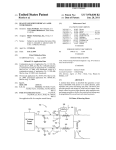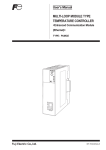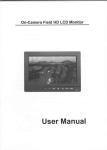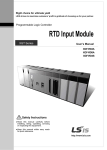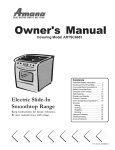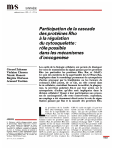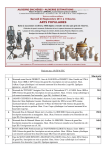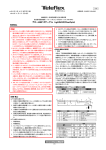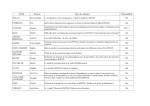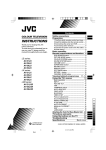Download “was
Transcript
US007437025B2 (12) Ulllted States Patent (10) Patent N0.: Kychakoff et al. (54) (45) Date of Patent: SENSING SYSTEM FOR DETECTION AND 5,462,358 A * 5,578,995 A * 11/1996 Bryant et a1. TUBES IN RECOVERY AND POWER BOILERS 5,646,338 A * 6,560,966 B1 * ( * ) Notice: Subject to any disclaimer, the term of this . . U.S.C. 154(1)) by 633 days. ) 7/1997 5/2003 340/627 Mercusot et a1. .. .... .. 73/86 Fetescu et a1. .............. .. 60/775 * Cited by examiner Primary ExamineriYOn Couso (57) ABSTRACT A system for detection and control of deposition on pendant tubes .111 recqleliy and power bollérs includes one O.r more about 4 or 8 7 microns and directl . . ' . . roducin ima es of the yP . g g mterlor of the bo1ler, or producmg feedmg s1gnals to a data A 1' N '2 11/137 089 pp 0 ’ (22) Filed: 10/1995 Werner ..................... .. 374/124 depos1t momtormg sensors operatmg 1n mfrared reg1ons of Patent 15 extended or adjusted under 35 21 Oct. 14, 2008 CONTROL OF DEPOSITION ON PENDANT (76) Inventors: George Kychakoff, 23618 SE. 25Lh s1, Maple Valley, WA (US) 98038; Martin A. Afromowitz, 4429 Forest Ave., Mercer Island, WA (US) 98040; Richard E. Hogle, 12424 Littlerock Rd., Olympla’ WA (Us) 98512 ( US 7,437,025 B2 processing system for information to enable a distributed control system by Which the boilers are operated to operate May 24, 2005 said boilers more ef?ciently. The data processing system mcludes an 1mage pre-processmg c1rcu1t 1n Wh1ch a 2-D (65) Prior Publication Data Us Zoos/0220331 A1 (51) (52) 00 G06K 9/00 image formed by the video data input is captured, and includes a loW pass ?lter for performing noise ?ltering of said video input. It also includes an image compensation system for array compensation to correct for pixel variation and dead Oct' 6’ 2005 2006 01 (2006'01) cells, etc., and for correcting geometric distortion. An image ( image pre-processing circuit for separating the image of the ' segmentation module receives a cleaned image from the ) U..S. Cl. ...... .... ...... ... .................... .. 382/312; 382/154 recovery boiler interior into baclqgrounds pendant tubes’ and Fleld 0f CIaSSI?CatIOII Search depOsitiOIL . . . . . . . . . . . . . . . .. 382/141, 154, 173, 224, 264, 285, 312; 431/12, 431/13, 75; 110/186, 234; 162/301: 30-11; _ _ 250/3191, 330, 333 also accomplishes thresholding/clustering On gray scale/texture and makes morphological transforms to smooth regions, and identi?es regions by connected compo nents. An image-understanding unit receives a segmented See aPPhCaUOn ?le for Complete Search hlstory- image sent from the image segmentation module and matches References Cited derived regions to a 3-D model ofsaid boiler. It derives a 3-D structure the deposition on pendant tubes in the boiler and U.S. PATENT DOCUMENTS provides the information about deposits to the plant distrib uted control system for more ei?cient operation of the plant (56) 4,539,588 A * 9/1985 5,219,226 A * 6/1993 Ariessohn et a1. ......... .. 348/164 5,355,845 A * 10/1994 Burgess et a1. 5,368,471 A * 11/1994 Kychakoffetal. .......... .. 431/12 James . . . . . . . . . . . . . . . ..... . . . .. 374/124 . . . .. 122/504 pendant tube cleaning and operating systems. 12 Claims, 8 Drawing Sheets 76 80 75 70 79 )1 “was 65 US. Patent 0a. 14, 2008 Sheet 1 of8 US 7,437,025 B2 35 35 Kraft Chemical Recovery Boiler 49/_ 37 37 l“\ ' _ q r\ Sensor Data-Processing System ‘\ 4O 47 Distributed Control System US. Patent 0a. 14, 2008 Sheet 2 of8 US 7,437,025 B2 60 2 Fig 92 US. Patent 0a. 14, 2008 Sheet 3 of8 US 7,437,025 B2 3 Fig U E 42 US. Patent 0a. 14, 2008 8% Sheet 4 of8 US 7,437,025 B2 9; Fig 4 55 L 3 99 [1 US. Patent 0a. 14, 2008 70 75 Sheet 6 of8 US 7,437,025 B2 f f 65 g 8 JW g: Q E, \/ 6078\ \ 96 73 US. Patent TrInRa(Pneas1mclo0tvie-hnrm)y 0a. 14, 2008 Sheet 7 of8 US 7,437,025 B2 (WMalvecrongst)h Fig 9 US. Patent 0a. 14, 2008 Sheet 8 of8 US 7,437,025 B2 vmE w moww 5IKI o:3mmmg mow?msEz:w 052 83 m:85ugms: CQ=E Qw o9. dm:29w6:5 6bm=>oum 26n9e8w2 coEwam 09mg 523819a Jon? AIR wncmEo l ' om 632m US 7,437,025 B2 1 2 SENSING SYSTEM FOR DETECTION AND CONTROL OF DEPOSITION ON PENDANT TUBES IN RECOVERY AND POWER BOILERS Various efforts to control the rate and quantity of deposits on the pendant tubes in the boiler have been undertaken in the past. These include adjustments to conditions of combustion, such as the noZZles that spray the black liquor into the com bustion chamber, and the Way air is introduced into the com bustion chamber. They also include systems, such as soot The US. Government has a paid-up license in this inven bloWers, for removing deposits on the tubes before they seri ously impact the operation of the boiler. These control efforts tion and the right in limited circumstances to require the patent oWner to license others on reasonable terms as pro vided for by the terms of Contract No. DE-FC36-99G010375 are most effective When they are immediately correlated to by the Department of Energy. the results they produce, but heretofore there has been no reliable method of determining directly the amount of depos This is related to US. Provisional Application No. 60/ 170, Dec. 14, 2000 and further to US. Ser. No. 10/168,277 ?led on its on the pendant tubes. Such control efforts have therefore necessarily been based on indirect measurements and consid Jun. 14, 2002, all entitled “Sensing System for Detection and erations, and have usually yielded unsatisfactory results. 839 ?led on Dec. 14, 1999 and to PCT/US00/33879 ?led on Control of Deposition on Pendant Tubes in Recovery and PoWer Boilers”. This invention pertains to a sensing system for detection and control of deposition on pendant tubes in Kraft recovery boilers, and more particularly to a mid-band infra-red imag ing system that is tuned to a particular spectrum of infra-red radiation to see into the otherWise visually impenetrable inte rior of a recovery boiler in operation to provide information about the condition of pendant steam tubes in the boiler. BACKGROUND OF THE INVENTION The severe environment of boilers, namely the high tem perature, turbulent gas ?oW, particle laden atmosphere, and intensity of radiation have made it di?icult to develop a sens ing system for detection and control of deposition on pendant tubes in Kraft recovery boilers that Would be economically 20 cameras for direct monitoring of pendant tube deposits have failed to reliably produce good images over the span of large boilers, and devices operating at longer Wavelengths have 25 In 1995, about 82% of the Wood pulp consumed at US time, but operated in a Wavelength region of 1.5-1.8 micron, Which has a relatively high susceptibility to light scattering by likely to decline as neW processes come on line, it is expected 35 sodium hydroxide and sodium sul?de, called White liquor. After cooking in the digester, the pulp is separated from the residual liquid called black liquor. Black liquor is an aqueous solution containing Wood lignins, organic material, and inor ganic compounds oxidiZed in the digester during the cooking SUMMARY OF THE INVENTION Accordingly, this invention provides a method of directly monitoring the depositions on recovery boiler pendant tubes. boiler to generate steam, Which is used in the pulp mill for The invention includes a focal plane array camera capable 45 called smelt, is collected in a molten bed at the bottom of the boiler and discharged to a dissolving tank to be recycled into neW White liquor. Kraft chemical and energy recovery boilers, in Which the black liquor is burned, are large and expensive, With capaci 50 55 The effective burning capacity of recover boilers is fre quently determined by the processes governing the deposi monitoring sensors feeding signals to a data processing sys tem under control of a distributed control system. Preferably, the deposit monitoring sensors include focal plane array cam eras operating in the mid-infra-red band, in the region of about 4-12 microns Wavelength. Clear images can be obtained at a loW cost of the boiler interior and particularly of the pendant Water and steam tubes in the boiler to enable for the ?rst time a visual real time inspection of the condition of the tubes and depositions thereon so that control schemes can be implemented. tion of fume, intermediate siZed particles, and carryover of partially burnt liquor/ smelt drops on heat transfer surfaces of the steam and Water tubes in the boiler, and the attendant of creating images in a particular range of infrared radiation that has loW absorption by molecules in the gas stream in a chemical recovery boiler, and is not scattered signi?cantly by particles normally present in the boiler gas stream. Another aspect of the invention is a system of one or more deposit ties installed in the last 30 years for pulp mills typically exceeding 1000 tons of pulp per day. It is dif?cult economi cally to add small incremental units of boiler capacity, so the capacity of the chemical recovery boiler is often the factor limiting the capacity of the entire pulp mill. particles in the boiler gas stream. Thus, there has long been a serious need for a deposition detection system for recovery boiler pendant tubes to solve the unful?lled requirement to monitor the degree and distri bution of fume, intermediate siZed particles, and carryover particle depositions on recovery boiler tubes. 40 process. It is concentrated and then burned in a recovery pulp cooking and drying, and other energy requirements. The material remaining after combustion of the black liquor, been impractical for boiler-side use because of prohibitive expense and the need for reliable cryogenic cooling. US. Pat. No. 4,539,588 entitled “Imaging of Hot Infrared Emitting Surfaces Obscured by Particulate Fume and Hot Gasses” issued on Sep. 3, 1985 to Peter C. Ariessohn and R. K. James discloses an improvement in the technology of the paper and paperboard plants Was produced using the Kraft process. Although the proportion of pulp from this source is that Well over 50% of Wood pulp production Will still be produced in 2020 using the Kraft process. In the Kraft pulp production process, a ?brous material, most commonly Wood chips, are broken doWn into pulp in a digester under pressure in a steam-heated aqueous solution of viable as a commercial product. Attempts to use near-IR 60 DESCRIPTION OF THE DRAWINGS plugging of gas passages betWeen and around those pendant The invention and its many attendant features and advan steam and Water tubes. Much effort has been made and con tages Will become clear upon reading the folloWing detailed tinues to be made to improving the understanding of the mechanism of particulate and vapor deposition on the tubes. HoWever, there are still no reliable on-line methods for sys tematically detecting the presence and build-up rates of these deposits. 65 description of the preferred embodiment, in conjunction With the folloWing draWings, Wherein: FIG. 1 is a schematic diagram of the invention installed in a Kraft recovery boiler; US 7,437,025 B2 4 3 LCD display screen 80 in the case of the hand-held unit FIG. 2 is a schematic elevation of a monitoring sensor shoWn in FIG. 1; shoWn in FIG. 3. The total length of the lens tube is about 36 FIG. 3 is an elevation of a hand-held sensor in accordance inches, permitting the focal plane to be located remotely from With this invention; the boiler port. The lens tube 55 is cooled and purged by a constant stream of air supplied at about 30 psi through a gas coupling 81 into the space betWeen the inner and outer tubes of the double-layered lens tube 55, through Which the air ?oWs and exits out through an axial opening 85 at the distal end of the lens tube 65. FIG. 4 is an elevation of the hand-held sensor of FIG. 3 showing the air ?oW system for the lens tube; FIG. 5 is a sectional end elevation of the a monitoring sensors shoWn in FIG. 2; FIG. 6 is a sectional elevation of the a monitoring sensor shoWn in FIG. 3 along lines 6-6 in FIG. 4; FIG. 7 is an enlarged sectional elevation of the distal end of Several camera models could be used: a ferroelectric array camera, a PtSi camera, and a Si microbolometer array cam the a monitoring sensor shoWn in FIG. 6; FIG. 8 is a schematic diagram of the optical elements in the sensor shoWn in FIG. 3; FIG. 9 is a graph shoWing the light transmission over a range of Wavelengths in a recovery boiler; and FIG. 10 is a schematic ?oW diagram of the process of receiving data from the monitoring sensors in FIGS. 1 and 3 to data input to the distributed control system in FIG. 1 for control of deposition control systems in the boiler. era. Also, an InSb array camera operating in the 3.9 micron Wavelength region, has produced adequate images but Was determined to be impractical because of its cost and the lim ited lifetime of the necessary loW temperature cooling sys tems required for operation of the camera. The ferroelectric array camera is attractive because it does not require cryo genic cooling, does not require frequent calibration and is 20 DESCRIPTION OF THE PREFERRED EMBODIMENT Turning noW to the draWings, and more particularly to FIG. 1 thereof, a deposition detection system in accordance With such as the superimposition of artifacts such as curved lines across the image. These problems can be addressed by chang 25 The sensor 35, shoWn in more detail in FIGS. 2 and 5-7, cameras. The microbolometer array camera does not require cryogenic cooling and does not use a chopper. It also has 30 The preferred camera is a ferroelectric array camera modi 35 are conducted via electrical lines 37 to a sensor data process ing system 40, shoWn in more detail in FIG. 10 and described in detail beloW. The hand-held sensor 36 shoWn in FIG. 3 40 vieWed on a display inside a hood 42 at the vieWer end of a camera body 44. A distributed control system 45, Which is the computer system used by paper mill or poWer plant operators for con trolling the operation of the plant, is connected to the sensor data processing system 40 by a link 47 for advanced control of the boiler operations in accordance With the information sup 45 3.5-4.0 microns, preferably about 3.9 microns; or infrared radiation in a Wavelength band of about 8.5-9.0 microns, preferably about 8.7 microns. This camera produces clear images in the system outlined above and is inexpensive enough to be affordable for pulp mills to purchase anduse. We anticipate that other imaging arrays usable in our camera Will be developed that Will be usable in the system shoWn in FIG. The sensor shoWn in FIG. 3 includes the camera body 44 connected to the lens tube 65 by Way of an intermediate structure 85. The intermediate structure 85 includes an adjust able iris 90 and the lens 60, Which is axially movable to give the lens train the ability of focus in a loW-light, Wide aperture 50 plant e?iciency. condition. The hand-held unit 37 has a poWer sWitch 94 and an electrical connector 96, Which provides the ability to con nect electronically into the distributed control system 45. The lens tube 55 is connected to a source 98 of air pressure Turning noW to FIG. 2, one embodiment of the deposit monitoring sensor 35 is shoWn having a focal plane array through a pressure regulator 97 and a ?exible air hose 99. The graph on FIG. 9 illustrates the bene?ts of operating in camera 50 and a lens tube 55 connected to the camera 50 by Way of a spectral band-pass ?lter 60 that limits the light ?ed to vieW infrared radiation in a Wavelength band of about 1 plied by the sensor data processing system 40, With operator judgement and analysis Where necessary, to minimiZe depo sition of the pendant steam tubes 49 and otherWise maximize signi?cantly greater dynamic range than the ferroelectric array camera. HoWever, it may require frequent (once-a-day) re-calibration to produce acceptable images, and is signi? cantly more expensive than the ferroelectric array camera. converts the acquired infrared data to electrical signals, Which converts the acquired infrared data directly to an image that is ing required solutions to achieve satisfactory images. The PtSi array camera requires cryogenic cooling and is quite expensive, making it a less preferred version of the usable this invention is shoWn installed in a Kraft recovery boiler 30. The deposition detection system includes one or several monitoring sensors 35, described in detail beloW, Which acquire data in the midband infra-red spectrum Within a par ticular ?eld of vieW from the interior of the recovery boiler. The monitoring sensors 35 could be ?xed in position to per manently monitor particular areas Within the boiler, or could be integrated hand-held units 36 shoWn in FIG. 3. relatively inexpensive. HoWever, it does use a semi-transpar ent “chopper” Wheel to limit the intensity of the light to the array. The chopper Wheel introduces its oWn set of problems 55 the regions of about 4 and 8.7 microns. As illustrated, there admitted into the camera 50 to a particular band in the mid-IR are several “Windows” available to vieWing the interior of a spectrum. The imaging optics consist of the double-layered steel lens characteristics of the gas and vapors in the gas stream of a chemical recovery boiler by virtue of the light absorption tube 55, shoWn in FIGS. 5-7, containing a train of ZnSe or, amorphous silicon lenses 65. The front lens 70 serves as the objective, and has a ?eld of vieW of at least 20°. Three other lenses 75, 76 and 77 serve as transfer optics, transporting the 60 image formed by the objective onto the focal plane array 78 of the camera 50. The electrical signals from the imaging array 78 are processed in the electronic circuitry 79 and transmitted to a remote processing system, in the case of the monitoring system shoWn in FIG. 2, or displayed on a display such as an 65 chemical recovery boiler for a pulp mill. The visibility of the boiler interior at these Wavelengths is also in?uenced by the scattering effect of the particles in the boiler gas. The effec tiveness of this particle scattering is greatly decreased at longer Wavelengths, and for Wavelengths in excess of 3 microns does not signi?cantly degrade images of recovery boiler interiors in the upper furnace and convection-pass sec tions. By operating an a region of loW absorption and loW scatter of the gas molecules and particles, respectively, in the US 7,437,025 B2 6 5 an elongated lens tube containing high IR tranamissivity optic elements and a spectral band-pass ?lter for passing boiler gas stream, the resolution of the images that are pos sible by infrared imaging in the chemical recovery boiler is maximized. Turning noW to FIG. 10, an image processing system 40 radiation in a preferred Wavelength band, coupled to a camera sensitive to said Wavelength band, said lens tube having a cooling channel to prevent excessive heating of said optic elements from the boiler. 2. A deposit monitoring sensor as in claim 1, Wherein said and a link to one version of the distributed control system is shoWn having a video input 90 from the camera 50 to an image pre-processing circuit 95 in Which the 2-D image is captured and noise ?ltering is performed in a loW pass ?lter. Array compensation is accomplished to correct for pixel variation and dead cells, etc., and geometric distortion is cooling channel comprises: an inner Wall of said lens tube in Which lenses are mounted, and an outer Wall surrounding said inner Wall; an inlet ?uid coupling at one end of said outer tube for corrected by image system compensation. A cleaned image 100 is sent from the image pre-processing circuit to an image segmentation module 105 Where the image of the recovery delivering a ?oW of cooling ?uid betWeen said inner Wall and said outer Wall of said tube; an outlet in said outer tube for conveying said cooling ?uid out of said outer tube through said outlet for cooling to boiler interior is separated into background, pendant tubes, and deposition. Thresholding/ clustering on gray scale/texture is accomplished and morphological transforms to smooth prevent excessive heating from the boiler. regions are made. Regions are identi?ed by connected com 3. A deposit monitoring sensor as in claim 1, Wherein said ponents. The segmented image 110 is sent from the image cooling channel comprises: segmentation module 105 to an image-understanding unit 115 Where derived regions are matched to a 3-D model of the recovery boiler and a 3-D structure 120 of the deposition is an inner Wall of said lens tube has in Which lenses are 20 inferred. Those deposition estimates can be provided to the distributed control system to update the computer model and an air coupling for connection to a source of air pressure for state 125 of the recovery boiler Which is fed back in a closed loop to continually update the image understanding unit 115. 25 The deposition estimates 120 are fed to the “soot-bloWer” control 130 for optimiZed control of the steam cleaning sys tem for the pendant tubes 49 in the boiler. A control scheme is envisioned that utiliZes the informa tion from the deposition detection system to control or mini 30 35 removal Will minimiZe the steam usage as Well as tube Wear can be optimiZed to minimize deposits on the pendant tubes. Obviously, numerous modi?cations and variations of the preferred embodiment described above are possible and Will become apparent to those skilled in the art in light of this 40 45 are described for the preferred embodiment, but in some uses of the invention, not all of these functions and advantages Would be needed. Therefore, We contemplate the use of the 50 of the invention are disclosed herein, but not all are speci? cally claimed, although all are covered by generic claims. Nevertheless, it is our intention that each and every one of 55 be encompassed and protected Within the scope of the folloW ing claims, and no dedication to the public is intended by virtue of the lack of claims speci?c to any individual species. Accordingly, We expressly intend that all these embodiments, species, modi?cations and variations, and the equivalents 60 thereof, are to be considered Within the spirit and scope of the invention as de?ned in the folloWing claims, Wherein We claim: The invention claimed is: 1. A deposit monitoring sensor for monitoring deposits on 8. A deposit monitoring sensor according to claim 1 Wherein: said cooling channel in said lens tube includes an inner Wall and an outer Wall surrounding and spaced from said inner Wall and de?ning therebetWeen an annular space for ?oW of cooling ?uid for conveying heat from said outer Wall and protecting said inner Wall and said lens tube from excessive heating from hot gasses in said boiler. 9. A deposit monitoring sensor according to claim 8 Wherein: said cooling channel in said lens tube includes a coupling and advantages. Moreover, several species and embodiments these species and embodiments, and the equivalents thereof, silicon materials. 5. A deposit monitoring sensor according to claim 1 Wherein said preferred Wavelength band is in the region of 4 microns. 6. A deposit monitoring sensor according to claim 1 Wherein said preferred Wavelength band is in the region of 8 .7 microns. 7. A deposit monitoring sensor according to claim 1 Wherein said camera includes a focal plane array. speci?cation. For example, many functions and advantages inventionusing feWer than the complete set of noted functions boiler. 4. A deposit monitoring sensor according to claim 1 Wherein: said optic elements comprise Zinc selenide or amorphous location of deposits and activates the steam cleaners, or “soot bloWers”, that are most appropriate to clean the affected loca caused by unnecessary over-cleaning. Moreover, it is noW possible for the ?rst time to accurately relate the deposition rate to the liquor burning parameters, so the boiler operation delivering a ?oW of cooling air betWeen said inner Wall and said outer Wall of said tube and for discharging said cooling air ?oW out through said opening at said distal end of said outer Wall; Whereby a ?oW of cooling air is established along said lens tube for cooling to prevent excessive heating from the miZe further deposition, or optimiZe deposit removal pro cesses. From the processed images, the system identi?es the tion and prevent pluggage. Currently, the “soot-bloWers” are operated “blind” on a timed cycle. Operating only the soot bloWers only Where and When there are deposits needing mounted, and an outer Wall surrounding said inner Wall, said outer Wall having an open distal end; 65 for connecting a source of air pressure to said lens tube for establishing a ?oW of cooling air around said inner tube. 10. A deposit monitoring sensor according to claim 8 Wherein: said cooling ?uid is Water. 11. A deposit monitoring sensor according to claim 9 Wherein said cooling channel in said lens tube includes an opening at the distal end of said tube through Which said cooling ?uid exits said lens tube. 12.A deposit monitoring sensor for monitoring deposits on pendant tubes in a Kraft recovery boiler or a poWer boiler, pendant tubes in a Kraft recovery boiler or a poWer boiler, comprising: comprising: US 7,437,025 B2 7 at least one deposit monitoring sensor having an elongated lens tube containing high IR transmissivity optic ele ments and a spectral band-pass ?lter for passing radia tion in a preferred Wavelength band, coupled to a camera sensitive to said Wavelength bandfeeding signals for 5 producing an image for sending to a data processing 8 system for generating information about deposition on said pendant tubes to enable a distributed control system by Which said boilers are operated to operate said boilers more e?iciently. US007437025C1 (12) EX PARTE REEXAMINATION CERTIFICATE (7 594th) United States Patent (10) Number: US 7,437,025 C1 Kychakoff et al. (54) (45) Certi?cate Issued: SENSING SYSTEM FOR DETECTION AND 5,615,953 A 5,646,338 A CONTROL OF DEPOSITION ON PENDANT TUBES IN RECOVERY AND POWER BOILERS 5,724,180 A 6,560,966 B1 Jul. 6, 2010 4/1997 Moskal 7/1997 Mercusot et al. * 3/1998 Wellman et al. .......... .. 359/359 5/2003 Fetescu et al. OTHER PUBLICATIONS (76) Inventors: George Kychakoff, 23618 SE. 25th St., Maple Valley, WA (U S) 98038; Martin Weyerhaeuser Co., Maintenance and Installation Manual, Version 2.0, High Temperature Imaging System/VIS, Pub A. AfromoWitz, 4429 Forest Ave., Mercer Island, WA (US) 98040; Richard E. Hogle, 12424 Littlerock Rd., lished by Sensor & Simulation Products, Tacoma, Washing ton 98477, Nov. 30, 1988. Olympia, WA (US) 98512 (Continued) Primary ExamineriDeandra M Hughes Reexamination Request: No. 90/010,515, May 18, 2009 (57) Reexamination Certi?cate for: (51) (52) (58) ABSTRACT A system for detection and control of deposition on pendant Patent No.: Issued: 7,437,025 Oct. 14, 2008 tubes in recovery and poWer boilers includes one or more App1.No.: 11/137,089 Filed: May 24, 2005 about 4 or 8.7 microns and directly producing images of the interior of the boiler, or producing feeding signals to a data processing system for information to enable a distributed control system by Which the boilers are operated to operate said boilers more ef?ciently. The data processing system includes an image pre-processing circuit in Which a 2-D Int. Cl. G06K 9/20 G06K 9/00 deposit monitoring sensors operating in infrared regions of (2006.01) (2006.01) image formed by the video data input is captured, and US. Cl. ...................................... .. 382/312; 382/154 Field of Classi?cation Search ...................... .. None includes a loW pass ?lter for performing noise ?ltering of said video input. It also includes an image compensation system for array compensation to correct for pixel variation See application ?le for complete search history. (56) and dead cells, etc., and for correcting geometric distortion. An image segmentation module receives a cleaned image from the image pre-processing circuit for separating the image of the recovery boiler interior into background, pen dant tubes, and deposition. It also accomplishes References Cited U.S. PATENT DOCUMENTS 3,021,386 3,609,236 4,005,327 4,539,588 4,679,891 4,709,381 5,096,502 5,219,226 5,355,845 A A A A A A A A A 2/1962 9/1971 1/1977 9/1985 7/1987 11/1987 3/1992 6/1993 10/1994 Clark Heilman Roosild et al. Ariessohn et al. Roberts Beaudet Carter et al. James Burgess et al. thresholding/clustering on gray scale/texture and makes morphological transforms to smooth regions, and identi?es regions by connected components. An image-understanding unit receives a segmented image sent from the image seg mentation module and matches derived regions to a 3-D model of said boiler. It derives a 3-D structure the deposition 11/1994 Kychakoffetal. on pendant tubes in the boiler and provides the information about deposits to the plant distributed control system for 5,462,358 A 10/1995 Werner more e?icient operation of the plant pendant tube cleaning 5,578,995 A 11/1996 Bryant etal. and operating systems. 5,368,471 A 30 35 Knfl chemical Rwmry w 49 111 $5 37 37 US 7,437,025 C1 Page 2 OTHER PUBLICATIONS Weyerhaeuser Co., High Temperature Imaging System/Lens Weyerhaeuser Co., Maintenance and Installation Manual, Tube, 1.75" Dia. Lens Tubes Maintenance Manual, Version Version 2.0, High Temperature Imaging System/IR, Pub 1.1, Published by Sensor & Simulation Products, Tacoma, WA 98477, copyright 1989. lished by Sensor & Simulation Products, Tacoma, Washing ton 98477, copyright 1989. Weyerhaeuser Co., High temperature Imaging Sensor Lens Tube, User Guide and Installation Manual, Published by Sensor & Simulation Products, Tacoma, Washington 98477, Jul. 1, 1992. RCA ClosediCircuit Video Equipment, TC1005/01 Cam eras, Installation and Operating Instructions, Serial No. 005838 and up, NeW Holland AVe., Lancaster, PA 1760443140 USA, Apr. 1984. Weyerhaeuser Co., High Temperature Imaging System/ Lens RCA ClosediCircuit Video Equipment, DXC*101/ 102, Tube, 2.13" Dia. Lens Tubes Maintenance Manual, Version Sony Service Manual, Apr. 1984. 1.0, Published by Sensor & Simulation Products, Tacoma, WA 98477, copyright 1989. Weyerhaeuser Co., High Temperature Imaging System/ Lens SYNiFAB Inc.High Temperature & Industrial CCTV Equipment, SE12 Solid State High Temperature Camera Tube, 1.50" Dia. Lens Tubes Maintenance Manual, Version System Speci?cations, Mobile, Alabama, Jul. 1995. 1.0, Published by Sensor & Simulation Products, Tacoma, WA 98477, copyright 1989. * cited by examiner US 7,437,025 C1 1 EX PARTE REEXAMINATION CERTIFICATE ISSUED UNDER 35 U.S.C. 307 2 boiler wherein said preferred wavelength band is in the region of 4 microns. 6. A deposit monitoring sensor [according to claim 1] for monitoring deposits on pendant tubes in a Kraft recovery boiler or apower boiler, comprising: THE PATENT IS HEREBY AMENDED AS INDICATED BELOW. an elongated lens tube containing high IR transmissivity optic elements and a spectral band-pass filter for pass ing radiation in a preferred wavelength band, coupled Matter enclosed in heavy brackets [ ] appeared in the to a camera sensitive to said wavelength band, said patent, but has been deleted and is no longer a part of the patent; matter printed in italics indicates additions made to the patent. lens tube having a cooling channel to prevent excessive heating of said optic elements from the boiler, wherein said preferred wavelength band is in the region of 8.7 microns. AS A RESULT OF REEXAMINATION, IT HAS BEEN DETERMINED THAT: 7. A deposit monitoring sensor according to claim [1] 5 Claims 1-3 and 8-11 are cancelled. wherein said camera includes a focal plane microbolometer array. Claims 4-7 and 12 are determined to be patentable as on pendant tubes in a Kraft recovery boiler or a power boiler, 12. A deposit monitoring sensor for monitoring deposits amended. 20 comprising: at least one deposit monitoring sensor having an elon 4. A deposit monitoring sensor according to claim [1] 5 gated lens tube containing high IR transmissivity optic wherein: elements and a spectral band-pass ?lter for passing radiation in a [preferred] wavelength band in the region said optic elements comprise Zinc selenide or amorphous silicon materials. 25 of 4 microns, coupled to a camera sensitive to said 5. A deposit monitoring sensor [according to claim 1] for wavelength bandfeeding signals for producing an monitoring deposits on pendant tubes in a Kraft recovery image for sending to a data processing system for gen erating information about deposition on said pendant boiler or a power boiler, comprising: an elongated lens tube containing high IR transmissivity optic elements and a spec tral band-pass filter for passing radiation in a preferred wavelength band, coupled to a camera sensitive to said wavelength band, said lens tube having a cooling channel to prevent excessive heating of said optic elements from the 30 tubes to enable a distributed control system by which said boilers are operated to operate said boilers more ef?ciently.
















